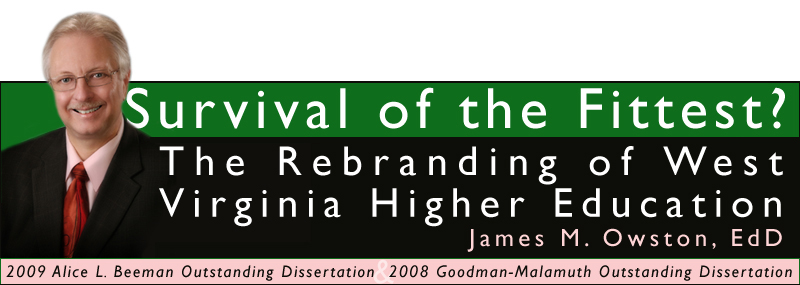You may access the dissertation through the links below:
Complete Dissertation: This link provides the complete version of the dissertation. Because of its length, you may
wish to download the dissertation by section.
Front Matter: This section includes the abstract, dedication, acknowledgements, table of contents, list of figures, and the list of tables.
Chapter One: Rebranding — An Introduction. The introductory chapter is equivalent to the first three chapters of a standard
dissertation and contains introductory remarks, a literature review, and the study's methods. Within this chapter there are brief histories of all of the
West Virginia institutions that have changed names since 1976. Possible reasons for rebranding are briefly discussed as well.
Chapter Two: Rationale for a "College-to-University" Change. This chapter explores the reasons
schools made the change. A primary focus is a comparison to Abraham Maslow's hierarchy of needs. Schools in WV are looked at rebranding as a means to fulfill survival,
security, and status needs. Additional reasons are also addressed in this chapter.
Chapter Three: Realizing the "College-to-University" Change. This section concentrates on the processes
involved in transitioning from a college to a university and focuses on structure, name choice, mascot and color changes, time frame, and funding.
The funding section provides a subsection on the help Senator Robert C. Byrd has provided certain institutions with appropriation dollars.
Chapter Four: Regulatory Bodies and the "College-to-University" Change. Two foci are presented
in Chapter Four — legislative involvement and degree approval agencies.
Chapter Five: Reactions to the "College-to-University" Change. Stakeholder reactions are presented in Chapter Five and include
an analysis of the reactions of students, institutional boards, administration, the community at large, faculty, alumni, former employees, and other institutions.
Chapter Six: Recruitment and the "College-to-University" Change. This chapter analyzed the
effect of the change upon enrollment. Several independent variables that affected enrollment are also explored. These include the switch from a
quarter system to a semester system in Georgia and the community college separation in West Virginia.
Chapter Seven: Reputation and the "College-to-University" Change. Several indicators
of prestige are addressed in Chapter Seven. These include Carnegie Classifications, an increased focus of graduate programs, tuition, undergraduate
selectivity, and the perception that the school had greater prestige and had attained and exhibited the "culture of a university."
Chapter Eight: Revisiting the "College-to-University" Change. Administrators reflect upon
what processes they would do differently if they had the opportunity to revisit the name change.
Chapter Nine Retaining an Institutional Brand: A Case Study Of The Allegheny Brand. This chapter
explores the usage of the Allegheny brand in higher education. Ten institutions are discussed in this chapter including the following historical cases:
Allegheny Theological Seminary in Pittsburgh (1825-1914), Alleghany College in Blue Sulphur Springs, VA (now WV) (1859-1861), Alleghany Collegiate Institute
in Alderson, WV (1888-1925), and Alleghany Collegiate Institute in Sparta, NC. The primary focus of the chapter is the branding struggles of Allegheny
College in Meadville, PA with institutions using the Allegheny brand. Focused schools include the Community College of Allegheny County, Allegany College of Maryland,
Allegheny University of Health Sciences, Penn State Greater Allegheny, and Allegheny Wesleyan College. Allegheny College's brand dominance is charted in the chapter's
final section. While the entire dissertation centers around West Virginia schools, there were no schools in the state that exhibited the brand protection and sheer brand dominance
as did Allegheny College in Meadville, PA. Their struggles with other institutions provides the greater context of this chapter.
Chapter Ten: Results and Recommendations - A Conclusion. The final chapter is a summary of the entire dissertation, results of the study,
limitations experienced, the implications of the study, and recommendations for further study.
References.
Appendices & Curriculum Vitae.
Additional Related Resources:
©2007-2019 James Martin Owston. Short portions of this document may be quoted without permission, although the author would like to know
how you used this information in your research. Larger portions will require permission. Email Owston with any comments at james.m.owston@gmail.com. He is
available to answer any questions regarding the research and writing of this dissertation. Thanks for visiting.


